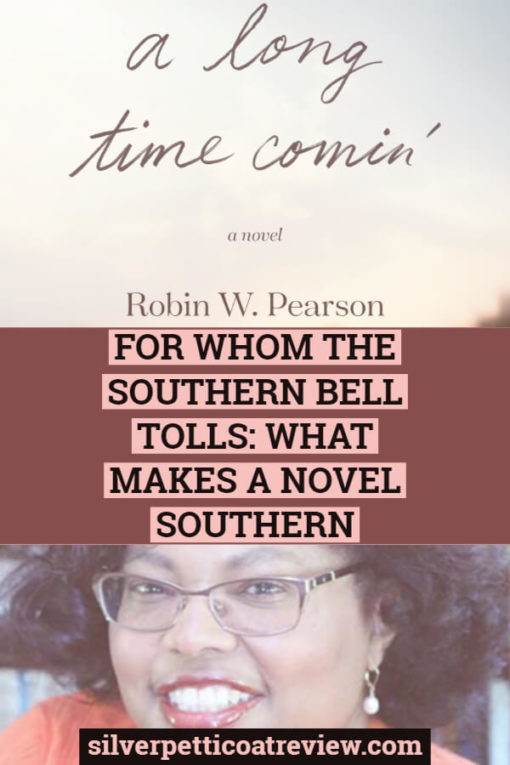Author, Robin W Pearson guest posts to discuss what makes a novel southern. Also, find out more about her debut book, A Long Time Comin’.
A few years ago, I was in my New Jersey kitchen, chatting with a girlfriend about summer plans. Out of the blue, she laughed and asked, “Did you just say ‘Joo-ly’?”
“What? July,” I repeated.
She chuckled harder this time. “Yes, you did. Joo-ly!”
I could tell she pictured me standing in the middle of a cornfield with a sprig of straw hanging from my mouth, but so be it. Her question had confirmed it, though it had taken moving north to see my first pig races at my first farm fair: I’m a product of the South and proud of it. And I don’t mean a particular part of a state, like South Jersey, but the real South. Where people say y’all, have cheese grits and Jimmy Dean sausage flowing through their veins, put a little bacon grease in almost every vegetable, and tell strangers all about their children while they’re thumping a watermelon in Harris Teeter’s produce department. Where you’re either wearing sweaters or you’re sweating at Christmastime, because it’s thirty degrees or eighty. And you say, “Joo-ly.”
But that’s what makes me Southern. What about my writing?
Obviously words are just as important. Yet as an author it’s the way I use them rather than how I pronounce them—unless of course I produce my own audiobooks. Even so, I can’t fill my pages with contrived sayings like “Well, bless your heart!,” “ain’t,” and “honey chile.” What delineates an amateur boxer from a prizefighter is his ability to not just punch, but land a blow in just the right spot, over and over, to knock out his opponent. And that’s my aim: to knock out my readers with my particular brand of Southern fiction, not diction. To deliver over and over, so that when the bell rings at the end of each round, they’ll stroke their chin and say, “Now, that’s a Southern writer.”
So how do I do that, deliver a well-delivered Southern punch? With love, my dear reader.
If you should show up on my doorstep unannounced, you’ll never know I wasn’t expecting company. I’ll welcome you with a hug, pour you up a glass of sweet tea, and ask you all about your mama’s people. When you lay out your troubles, I’ll squeeze your hand to comfort you or pat your shoulder because I can’t just help myself. I’ll pray with you, because my faith is the source and outpouring of my love. And after you’ve sipped your last and set down your condensation-covered glass on my antique coffee table, I will walk you to the foyer, wrap my arms around you, and remind you, “Tell your mama I asked about her!” before I close the door, take a deep breath, and put my pajamas back on.
And that’s just what Southern fiction does. It touches you and connects with you, right down to your spirit. It tries to take you to church and hit you where it hurts. It embraces you and invites you to stay a while before it ends the visit on just the right note. Within its pages, you’ll find at least one character who reminds you of that cousin you used to play with, the neighbor who let you climb his fence to get your ball, the sermon that stepped all over your toes, or the grandma who either covered your face with kisses or swatted you on the behind—whatever you needed at the time.
Part of that warm touch comes naturally. We’re born and bred in a part of the country that enjoys the love of the sun a little longer during the year. You get more skin-to-skin contact because we generally wear fewer clothes and bare more arms and legs, and our uncovered cheeks more readily receive a kiss or bump of greeting. Many of us don’t reject a hug; they’re as commonplace as a wave or a handshake.
In other words, our love flows from our position on the map—our setting—another integral part of Southern fiction. Weeping willows, crepe myrtles, flowering dogwoods, and palmettos. Myrtle Beach, the Outer Banks, the Gulf. The Smoky Mountains, the Low Country, bayous, and North Carolina clay. Cottonfields and soybeans, peach groves and pecan trees. Heat and humidity, thunderstorms, long summers and short winters. Front porches, tire swings, and gravel roads.
Yet we can’t forget the New Orleans skyline, Charlotte’s financial district, and Atlanta’s rush-hour traffic. Coliseums, art museums, science centers, and nationally ranked universities. Football, baseball, and even championship hockey teams. Strip malls, modern condos, and Chipotle. Yes, it’ll take more than a Louisiana plantation and wearing flip-flops and cutoff shorts in November to completely paint a Southern picture.
And it’ll take something other than a Jersey tomato to convey the Southern palate, for sounding, feeling, and looking like the South aren’t enough; my work had better taste like the South. Just like other parts of the country, we have our foods that reflect our history and culture, goodies like po’boys, grits, pound cake, greens, and fried pork chops. The what, why, and how we eat tell a story. Just ask Beatrice Agnew, my main character in A Long Time Comin’. Like my mama, she shows love through her food, and you requite that love by cleaning your plate and asking for more. My Southern fiction tantalizes the taste buds from chapter one and doesn’t allow room for calorie counting.
So what puts the Southern in fiction? It’s the warmth of the sun on the back of the neck, the beauty of the scene that praises its Creator, and the spirit that bids the reader to sit down and rest a little while. It’s the shared history that once separated us, in the letters we leave off our words, and the rhythm of the heart and soul we pour into them.
Can I get an amen, y’all?
About the Author

Robin W. Pearson’s writing sprouts from her Southern roots and her love of her husband and seven children. Both lend authenticity to her debut novel, A Long Time Comin’. After graduating from Wake Forest University, she has corrected grammar up and down the East Coast in her career as an editor and writer that started with Houghton Mifflin Company twenty-five years ago. Since then she has freelanced with magazines, parenting journals, textbooks, and homeschooling resources. Follow her on her blog, Mommy, Concentrated, where she shares her adventures in faith, family, and freelancing.
Author Links:
About A Long Time Comin’

To hear Beatrice Agnew tell it, she entered the world with her mouth tightly shut. Just because she finds out she’s dying doesn’t mean she can’t keep it that way. If any of her children have questions about their daddy and the choices she made after he abandoned them, they’d best take it up with Jesus. There’s no room in Granny B’s house for regrets or hand-holding. Or so she thinks.
Her granddaughter, Evelyn Lester, shows up on Beatrice’s doorstep anyway, burdened with her own secret baggage. Determined to help her Granny B mend fences with her far-flung brood, Evelyn turns her grandmother’s heart and home inside out. Evelyn’s meddling uncovers a tucked-away box of old letters, forcing the two women to wrestle with their past and present pain as they confront the truth Beatrice has worked a lifetime to hide.
Buy the book HERE




Wonderful post! Thanks from this Southern author. Congratulations and prayers for your success.